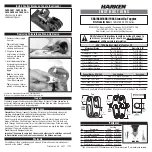
Mathematics
R&S
®
RTM20xx
104
User Manual 1317.4726.02 ─ 01
"Subtraction"
Op1 - Op2
Subtracts the second operand from the first operand.
"Multiplication"
Op1 * Op2
Multiplies the two operands.
"Division"
Op1 / Op2
Divides the first operand by the second operand.
For small amplitudes of the second operand, the result increases
quickly. If the second operand crosses zero, the result would be a range
of +
∞
to -
∞
. In this case, instead of 0V, the calculation function uses the
value that the Least Significant Bit (LSB) of the second operand repre-
sents. (For an 8-bit value, for example, 1/256).
You can limit the zero-crossings of the operand by using the "Maxi-
mum" operator. This limitation results in a smaller result range and a
finer resolution.
"Maximum"
Maximum (Op1, Op2)
Compares the amplitudes of both operands and displays the maximum
amplitude. The sign of the result is taken from Operand1. Use this
operation in combination with the "Reciprocal" or "Division" operation
to limit the minimal amplitudes of an operand.
Example:
Operand1 is a homopolar sine signal with V
pp
=3V. Operand2
is a constant value of 1V. The result is always larger than 1V or smaller
than -1V.
Reference for Mathematics
















































